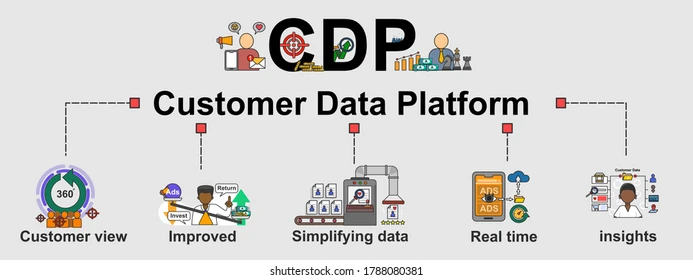
In today’s digital landscape, businesses constantly seek more profound insights into their customers’ behaviors and preferences. One revolutionary solution that has emerged to address this need is using customer data platforms. With their ability to centralize and analyze customer data from various sources, CDPs have become indispensable tools for modern marketers and businesses.
Customer Data Platforms (CDPs)
Customer Data Platforms (CDPs) represent a paradigm shift in how businesses manage and utilize customer data. These platforms serve as centralized hubs for collecting, organizing, and analyzing data from various sources, including websites, mobile apps, and offline interactions.
By integrating data silos, CDPs offer a holistic view of customer behavior and preferences across multiple touchpoints. This comprehensive understanding enables businesses to personalize marketing efforts, improve customer experiences, and drive strategic decision-making.
Unlike traditional CRM systems, CDPs handle large volumes of real-time data, empowering enterprises to adapt quickly to evolving market dynamics. CDPs are indispensable tools for companies seeking to thrive in today’s data-driven landscape.
The Importance of Customer Data Platforms
Customer data platforms (CDPs) play a pivotal role in modern business strategies due to their significance in understanding and engaging with customers effectively. These platforms enable businesses to aggregate and analyze data from diverse sources, offering insights into customer behavior, preferences, and interactions across various touchpoints.
By centralizing customer data, CDPs facilitate the creation of unified customer profiles, which empower businesses to deliver personalized experiences and targeted marketing campaigns.
Moreover, CDPs enhance customer engagement and loyalty by enabling enterprises to anticipate needs and provide tailored solutions. In today’s competitive landscape, effectively harnessing data makes customer data platforms indispensable tools for organizations striving to stay ahead and meet evolving customer expectations.
Key Features of Customer Data Platforms

Critical features of customer data platforms encompass their ability to seamlessly integrate data from various sources, enabling businesses to create comprehensive customer profiles. These platforms facilitate data organization and analysis, providing insights into customer behavior, preferences, and interactions across multiple channels.
Additionally, customer data platforms offer functionalities such as advanced segmentation, real-time data processing, and personalized marketing automation. They empower businesses to make informed decisions, optimize marketing strategies, and enhance customer experiences by leveraging data.
Data Integration
Data integration is a cornerstone of modern business operations, facilitating the seamless flow of information across various systems and platforms. It consolidates data from disparate sources, such as databases, applications, and cloud services, into a unified format. Data integration allows businesses to comprehensively view their operations, customers, and market trends.
This consolidated data enables informed decision-making, improved analytics, and enhanced operational efficiency. By breaking down data silos and allowing real-time access to information, data integration empowers organizations to unlock valuable insights and drive innovation in today’s data-driven world.
Customer Profiling
Customer profiling involves businesses strategically crafting detailed portraits of their clientele, considering various attributes and behaviors. It consists of collecting and analyzing data such as demographics, purchase history, browsing patterns, and interactions with the brand.
Through customer profiling, businesses gain insights into their target audience’s preferences, needs, and interests, allowing for more personalized marketing campaigns and tailored product offerings. By understanding the characteristics and behaviors of their customers, businesses can effectively segment their audience, optimize marketing strategies, and ultimately enhance customer satisfaction and loyalty.
Unified Customer View
The Unified Customer View comprehensively represents customer data aggregated from various touchpoints and sources. It provides businesses with a cohesive perspective of each customer, encompassing their interactions, preferences, and transactions across different channels.
By consolidating data into a unified view, businesses can better understand customer behavior, tailor their marketing efforts, and deliver personalized experiences. This holistic approach enhances customer engagement and fosters more robust relationships between companies and their clientele.
Benefits of Using Customer Data Platforms
The benefits of using customer data platforms are manifold. These platforms enable businesses to gain deeper insights into customer behavior, preferences, and trends, facilitating personalized experiences. By leveraging data analytics and segmentation capabilities, companies can effectively tailor their marketing efforts to target specific customer segments.
Customer data platforms also enhance customer engagement, foster loyalty, and drive revenue growth by optimizing marketing campaigns and improving overall customer satisfaction. Additionally, these platforms help businesses streamline operations, optimize resource allocation, and stay competitive in today’s dynamic marketplace, ultimately leading to improved business performance and profitability.
Enhanced Customer Experience
With access to comprehensive customer profiles, businesses can deliver highly personalized experiences across all touchpoints, increasing customer satisfaction and loyalty.
Personalized Marketing Campaigns
CDPs empower marketers to create hyper-targeted marketing campaigns based on individual customer preferences and behaviors, resulting in higher conversion rates and ROI.
Improved Customer Retention
By understanding customer needs and preferences, businesses can proactively address issues and provide timely support, fostering long-term customer relationships and reducing churn rates.
Top Customer Data Platforms in the Market
Several top players stand out in the competitive landscape of customer data platforms (CDPs).
Segment
Segment is a leading customer data platform renowned for its user-friendly interface and robust analytics capabilities. It empowers businesses to collect, clean, and control customer data effectively. Through Segment, companies can gain actionable insights and drive growth by leveraging data-driven strategies. With its seamless integration and advanced features, Segment remains a preferred choice for businesses seeking to optimize their data management processes.
Salesforce Customer 360

Salesforce Customer 360 is a comprehensive customer data platform that connects customer data across Salesforce apps and external systems. With AI-powered insights and predictive analytics, Customer 360 enables businesses to deliver personalized experiences at scale. It provides a unified view of customer interactions and empowers organizations to drive engagement, streamline operations, and foster long-term customer relationships.
Adobe Experience Platform
The Adobe Experience Platform is a powerful customer data platform that enables businesses to collect and activate customer data in real time. With its AI-driven insights and omnichannel orchestration capabilities, the Adobe Experience Platform helps companies deliver seamless experiences across all touchpoints.
It empowers organizations to leverage data-driven strategies, personalize customer interactions, and drive engagement at scale, thereby enhancing overall customer satisfaction and loyalty.
Factors to Consider When Choosing a Customer Data Platform
Several vital factors merit consideration when selecting a customer data platform (CDP). Data security is paramount, ensuring compliance with regulations like GDPR and CCPA.
Data Security

Customer data platforms (CDPs) are paramount to protecting sensitive customer information from unauthorized access and breaches. Adhering to stringent security measures and compliance regulations such as GDPR and CCPA is crucial for maintaining trust and safeguarding customer privacy. Robust encryption, access controls, and regular audits are essential to a comprehensive data security strategy.
Scalability
Scalability is integral to customer data platforms (CDPs), enabling them to accommodate growing data volumes and expanding business needs. A scalable CDP can seamlessly handle increased data processing demands without compromising performance or reliability.
It allows businesses to adapt to changing requirements, add new functionalities, and support a more extensive user base over time. Scalability ensures that CDPs remain agile and effective in meeting evolving business challenges and opportunities.
Integration Capabilities
Integration capabilities are vital for customer data platforms (CDPs), enabling seamless interoperability with existing systems and third-party applications. CDPs with robust integration capabilities can effortlessly connect with various data sources and platforms, ensuring smooth data flow and accessibility.
Businesses can leverage integrated CDPs to consolidate disparate data silos, streamline workflows, and derive actionable insights from comprehensive datasets, enhancing operational efficiency and decision-making processes.
Implementing a Customer Data Platform Strategy
Implementing a Customer Data Platform (CDP) strategy involves several key steps.
Define Objectives
Defining objectives is the foundational step in implementing a successful Customer Data Platform (CDP) strategy. Businesses must clearly outline their goals and key performance indicators (KPIs) to align CDP initiatives with organizational objectives.
By articulating specific objectives, such as improving customer engagement or increasing revenue, businesses can effectively measure the success of their CDP implementation and drive meaningful outcomes aligned with their overarching goals.
Data Collection and Integration

Data collection and integration involve gathering information from various sources and consolidating it into a unified system. This process ensures that businesses can access comprehensive datasets for analysis and decision-making. Effective data collection and integration strategies enable organizations to derive valuable insights and drive actionable outcomes from their data assets.
Analyzing Customer Insights
Analyzing customer insights is critical to effectively leveraging customer data platforms (CDPs). Businesses can uncover valuable trends and patterns by examining customer behaviors, preferences, and interactions.
Through advanced analytics tools and techniques, organizations can derive actionable insights to inform strategic decision-making, optimize marketing campaigns, and enhance overall customer experiences, ultimately driving business growth and success.
Challenges in Implementing Customer Data Platforms
The challenges of implementing customer data platforms (CDPs) are multifaceted.
Data Privacy Regulations
Data privacy regulations, such as GDPR and CCPA, impose strict requirements on businesses regarding customer data collection, processing, and storage. Compliance with these regulations is essential to protect customer privacy and avoid legal repercussions.
Companies must implement robust data privacy measures, including consent mechanisms, encryption, and transparent data handling practices, to ensure compliance and maintain customer trust.
Integration Complexity
Integration complexity refers to the challenges businesses face when integrating customer data platforms (CDPs) with existing systems and data sources. These challenges include data format inconsistencies, API compatibility issues, and synchronization difficulties.
Overcoming integration complexity requires careful planning, robust technical capabilities, and collaboration across departments to ensure seamless data flow and interoperability between systems, maximizing the effectiveness of the CDP implementation.
Future Trends in Customer Data Platforms
Future trends in customer data platforms (CDPs) include the integration of AI and machine learning for automated data analysis and real-time processing capabilities to deliver instant insights and personalized experiences. These advancements are poised to revolutionize customer data management and drive enhanced business outcomes.
AI and Machine Learning Integration
Integrating AI and machine learning into customer data platforms (CDPs) revolutionizes data analysis and decision-making processes. AI algorithms enable CDPs to automate data processing, uncover insights, and predict customer behavior accurately.
By harnessing the power of AI and machine learning, businesses can deliver personalized experiences, optimize marketing strategies, and drive customer engagement to unprecedented levels, enhancing overall business performance.
Real-Time Data Processing

Data processing is crucial in modern customer data platforms (CDPs), enabling businesses to analyze and act on data instantaneously. With real-time processing capabilities, CDPs can provide up-to-the-minute insights into customer behaviors and market trends. This agility allows companies to make timely decisions, personalize interactions, and respond promptly to changing customer needs, fostering stronger relationships and driving growth.
Conclusion
In conclusion, customer data platforms (CDPs) have revolutionized how businesses understand and engage with customers. CDPs offer invaluable insights into customer behavior and preferences by aggregating and analyzing vast amounts of data from multiple sources.
This comprehensive understanding enables businesses to tailor marketing campaigns, improve customer experiences, and drive revenue growth. Despite challenges such as data privacy regulations and integration complexities, the benefits of implementing a CDP strategy far outweigh the obstacles.
As technology evolves, CDPs will play an increasingly pivotal role in helping businesses stay competitive and agile in the ever-changing marketplace. Embracing CDPs empowers businesses to forge stronger customer relationships and capitalize on opportunities for innovation and growth.
2. How can businesses ensure data privacy when using Customer Data Platforms?
Businesses can ensure data privacy by implementing robust security measures, obtaining customer consent for data collection, and adhering to relevant regulations such as GDPR and CCPA.
3. What role do Customer Data Platforms play in omnichannel marketing?
Customer Data Platforms enable businesses to deliver consistent and personalized experiences across multiple channels, ensuring a seamless customer journey.
4. How can small businesses benefit from using Customer Data Platforms?
Small businesses can benefit from Customer Data Platforms by gaining valuable insights into customer behavior, optimizing marketing efforts, and improving customer retention rates.
5. What are some common challenges businesses face when implementing Customer Data Platforms?
Common challenges include data integration complexity, ensuring data accuracy and consistency, and navigating regulatory compliance requirements.







